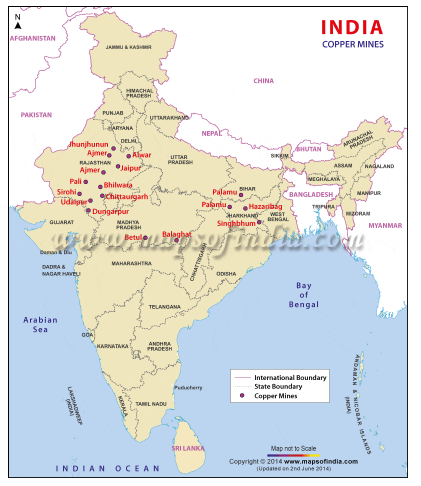Current State of Copper Production in India (GS Paper 2, Growth & Development)

Why is this Important
- Copper is crucial for a wide range of industries, from defense and telecommunications to power infrastructure and renewable energy technologies.
- Despite its significance, India’s copper ore production has recently faced challenges, impacting its ability to meet domestic demand and driving an increase in copper concentrate imports.
- Understanding the current state of copper production and reserves in India is essential for comprehending the broader economic and industrial implications.
Copper Metal and Reserves in India
Overview of Copper
- Copper is a versatile metal known for its excellent thermal and electrical conductivity.
- It is used in various applications, including electrical cables, power generation, and telecommunication systems.
- Unlike many metals, copper can be found in its native metallic form in nature, which simplifies its extraction and use.
Reserves of Copper in India
India holds approximately 2% of the world’s copper reserves. The distribution of these reserves is as follows:
- Rajasthan: Home to the largest reserves, with about 813 million tonnes (Mt), representing 53.81% of the nation’s total copper resources.
- Jharkhand and Madhya Pradesh: Significant reserves are also located here.
- Other States: Copper reserves are found in Andhra Pradesh, Gujarat, Haryana, Karnataka, Maharashtra, Meghalaya, Nagaland, Odisha, among others.
The Khetri Mine in Rajasthan is one of the largest copper mines in India, underlining the state's prominence in copper production.
Current Status of Copper Ore Production
Production Trends
- India’s production of copper ore has seen a decline, dropping from 4.13 million tonnes (Mt) in FY19 to 3.78 Mt in FY24.
- This reduction has led to a substantial increase in imports of copper concentrates, which have doubled to ₹26,000 crore in FY24 compared to FY19.
Domestic Supply and Demand
- India’s copper industry is not self-sufficient.
- The country relies on a combination of domestic production, recycling, and imports to meet its copper and copper alloy needs.
- In the copper value chain, ore is first smelted into copper anode, which is then refined into copper cathode.
- This refined copper is crucial for producing various products, including rods, sheets, and wires.
Key Players in the Industry
- Hindustan Copper Limited (HCL): The sole integrated public sector company involved in the entire copper production process in India, from mining and beneficiation to smelting and refining.
- Private Sector: Companies like Hindalco Industries Ltd and Vedanta Limited are major producers but primarily depend on imported copper concentrates. These firms also own copper mines abroad to secure their supply chains.
Challenges and Future Prospects
Exploration and Development
- India’s copper reserves are estimated at 208 Mt, but most are of low grade.
- The total copper resources amount to 1.51 billion tonnes, requiring extensive exploration to identify and develop viable reserves.
- The National Mineral Exploration Trust (NMET) manages mineral exploration in India but has faced challenges:
Limited Exploration:
- In FY24 and FY23, only two copper exploration projects were approved.
Policy and Participation:
- Recent modifications to exploration rules aim to encourage private sector involvement in critical minerals like copper, but the results of these changes remain to be seen.
Increasing Import Reliance
- The critical role of copper in clean energy technologies, such as wind turbines and electric vehicle (EV) batteries, has intensified India’s need to secure a stable supply.
- Efforts are underway to diversify import sources by developing new partnerships with copper-rich countries like Mongolia and investing in mining operations in Zambia and Chile.
Conclusion
- India's copper production and supply chain face significant challenges, including declining domestic production and increasing reliance on imports.
- While there are efforts to address these issues through exploration policy reforms and international partnerships, the country’s ability to secure a stable and sufficient copper supply will be crucial for its industrial and technological development.


